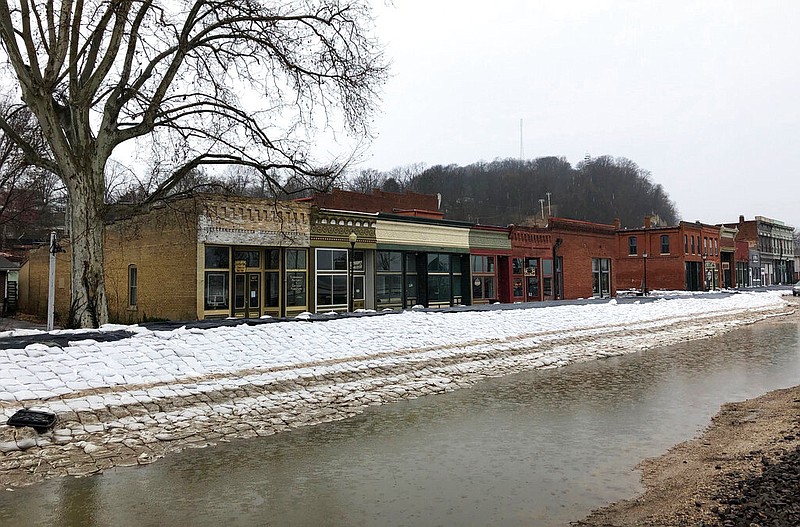State Sen. Dan Hegeman, R-Cosby, represents most of Northwest Missouri - an area that's seen a lot of flooding this spring.
He wants the Senate and House to pass a resolution urging the U.S. Army Corps of Engineers to make sure flood control is its first priority in managing the Missouri River.
"This resolution is in response to the flooding that's taken place in Northwest Missouri," he told members of the Senate's Rules, Joint Rules and Ethics Committee on Tuesday. "In 2004, the Corps changed (its) Master Manual to de-emphasize flood control.
"This resolution would call on the Corps to make flood control a priority to protect the property and lives of those who live along, and farm along, the Missouri River."
After major flooding in the mid-1940s, Congress authorized the Corps of Engineers to develop flood control measures throughout the Missouri River Basin, which runs from central Montana to just north of St. Louis.
As a result of that mandate, the Corps designed and built six major dams along the upper Missouri River, with the closest one to Missouri at Gavins Point, at the Nebraska-South Dakota border - about 4 miles from Yankton, South Dakota, and 811 river miles from the Missouri's confluence with the Mississippi River.
There also are several dams built on smaller streams that feed the Missouri - including the Truman Dam on the Osage River, upstream from the Lake of the Ozarks.
The Master Manual, which is updated occasionally, after the Corps holds a series of public hearings throughout the Missouri River Basin territory, is the Corps' guide for how it manages the river.
As part of its mandate, Congress gave the Corps eight priorities for managing the Missouri River and its tributaries: flood control, river navigation, hydroelectric power, irrigation, water supply, water quality, recreation, and fish and wildlife (including preservation of endangered species).
Hegeman told the committee: "When you have eight different things (as) a priority, you have no priorities."
He said U.S. Sen. Roy Blunt and U.S. Rep. Sam Graves - whose congressional district includes Northwest Missouri - have been working to get the Corps of Engineers "to look at changes to the Master Manual."
And, he noted, Missouri Gov. Mike Parson has met with the governors of Iowa and Nebraska, to talk about common issues with river management.
"We have long-experienced numerous flooding events in Missouri," Hegeman told the committee, adding the Corps' river management began changing after the record-setting floods of 1993.
"I think it's fine-time that we ask for a re-evaluation of how the Corps manages the river."
Sen. Tony Luetkemeyer, R-St. Joseph, a Rules Committee member who co-sponsored Hegeman's resolution, said: "To me, it's incomprehensible that you would have the federal government prioritizing fish and wildlife over people and family farms and small business owners."
Dale Amick, representing the Missouri Corn Growers, testified in favor of the resolution.
No one opposed it in the committee hearing.
However, there are people and groups who said the river should be allowed to roam more freely, covering the flood plain when needed, then falling back into its banks.
Hegeman told reporters: "We have spent decades (since) the late-1800s and early-1900s, to manage the river and to develop these lands into productive, fertile ground so we can produce food for the world.
"I would hate for us to turn our backs on that need to produce additional output in food for the world - it is a wrong-headed way to do that, and I think we need to continue to support our farmers and our economies, all along, up and down the river."
Last month, officials estimated more than $2 billion in flood-caused damage this spring in Missouri, Iowa, Nebraska and Kansas.
However, Hegeman told reporters after the committee hearing, he's waiting for the State Emergency Management Agency's updated report on just the damage experienced in Northwest Missouri - even though some areas still are under five feet or more of flood waters.
"We're able to see much of the damage, now," he explained. "We're seeing some of the roadway (and) levee damage now.
"The emergency managers in the various counties are putting together a list of all the infrastructure damage, to compile a larger list with SEMA."
Hegeman also chairs the Senate's Appropriations Committee.
He told reporters the budget bills expected to be debated in the Senate today still include a $5 million appropriation for state help with flood damage expenses.
"That's probably a good number that will address most of the needs that we have," he said. "If not, we can always come back (next year) with a supplemental appropriation and address that."
Hegeman told the committee it's too late for farmers to plant crops this year.
"And if we don't get the levees repaired along the river, they won't be able to, safely, put a crop in next year," he said. "It's vitally important to the economy of Northwest Missouri."

